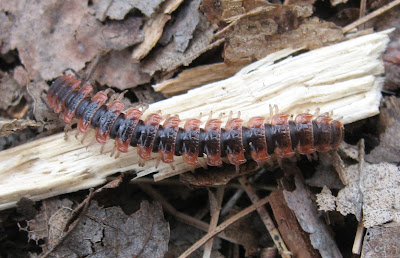The weather has been cool and overcast and most insects have gone into hiding to sit it out. Since there was a paucity of animals to photograph in the woods and fields it looked like a good time to take a peek beneath some rocks, logs and leaf litter. There's an entire world we’re seldom aware of under the surface of the soil, with an ecology of its own that both provides the support for and receives nourishment from the living things above.
Cornfield Ants or Citronella Ants (Acanthomyops sp., a subgenus of Lasius) – due to their subterranean lifestyle these common ants are rarely encountered. This group is scurrying to move their larvae to a safer place.
Even though they seemed on the large side, in the field I still mistook the rounded yellowish objects seen in the next photo for eggs. When I zoomed in on the image on my computer, my wonder of modern technology revealed that these were not eggs, but root aphids.
Many species of ants are symbiotic with aphids, guarding and "farming" them for the honeydew the aphids produce. But – these are called "ant-obligate" root aphids. Obligate meaning what? ... do they totally rely on the ants to complete their life cycle? No one has answered this intriguing question at BugGuide.Net, and I can't find it elsewhere on the Internet.
A "wireworm", the larval stage of a Click Beetle ... I have no idea what species.
Another insect larva – the immature incarnation of a Fishfly (Chauliodes sp.). Having overwintered underwater, it has abandoned its aquatic abode and prepared a cozy place under a rock where it can pupate. The small red "bug" to the left of the Fishfly is a Velvet Mite (an arachnid, related to a spider), and to the right is a Sowbug (actually a crustacean, like a crayfish).
Although it's not an uncommon insect, only those of us who have nothing better to do with our lives than roll over rocks and rotten logs are apt to chance upon the Camel Cricket. This one is probably genus Ceuthophilus, and it is not only virtually blind, depending on its long antennae and legs to navigate its stygian environment, but is wingless and unable to chirp like many other cricket species. The lack of an ovipositor indicates it's a male.
A Wood Cockroach, probably Parcoblatta sp. – judging by their numbers these insects won't be making the endangered species list any time soon ...
One of the common small cylindrical millipedes, probably order Julida. Millipedes have two pairs of legs on each body segment, and in most groups the legs on the seventh ring are modified copulatory organs called gonopods, the shape of which is an aid in identifying species. However, I didn’t examine any of the millipedes in the field, nor did the camera capture enough detail for me to guess at assigning a family, let alone a genus or species name.
If they feel threatened millipedes will often curl up in a spiral defensive posture, presenting their tough exoskeletons to the outside world. Some species also exude fluids that would-be predators find noxious.
Based on the number and profile of the body rings, this millipede found creeping about in the woodland leaf litter belongs to the order Polydesmida. Beyond this, I can’t say whether the two differently colored millipedes belong to different species. For all I know, the pale millipede in the first two images is the same species but has just recently molted.
Lithobius forficatus, the ubiquitous Stone Centipede. Centipedes have one pair of legs per body segment – always an odd number of pairs. The modified first two appendages, called forcipules, bear venom and are a feature unique to centipedes.
A closeup view of the forcipules.
Less often seen is the Soil Centipede (Geophilus flavus). This species can move both backwards and forwards with equal facility. According to one of my field guides these blind centipedes can penetrate as deep as 40 to 70 cm into the soil in search of insect larvae and worms.
Moving on to a couple of representatives of the order Isopoda, terrestrial crustaceans distantly related to crabs, lobsters, and much closer cousins of the freshwater isopods I photographed last autumn. Isopods have seven pairs of similar legs ... "iso" → same, "pod" → foot ... as opposed to, for example, a crab, which has very specialized appendages.
The Sowbug, genus Porcellio, has a three lobed head and two segments on the flagellum, the end of the long antennae. (Also like other crustaceans, Isopods have two pairs of antennae.) This woodlouse cannot curl up in a ball when disturbed.
On the other hand, the European Sowbug (Oniscus asellus) is often called a Pillbug because it can roll up if it feels endangered. The body ends in a two pointed telson (the telson being terminal body segment), and the flagellum consists of three segments.
"Bugging out" when life gets too scary ...






















